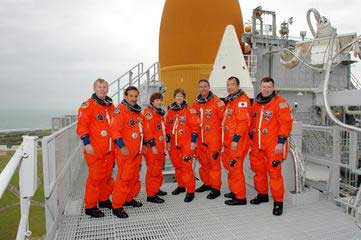The initial lessons from the STS-114 space mission, while examining the technical/engineering aspects of the operation, the implications of its results for the future of the space shuttle program and the International Space Station, and for NASA as a whole. First article of two
Amber dew

The Discovery shuttle crew in a group photo during training for the mission
Direct link to this page: https://www.hayadan.org.il/inbar220905.html
The Space Shuttle Discovery mission known as STS-114 was the first space shuttle mission since the Space Shuttle Columbia disaster of February 1.2.2003, XNUMX. The mission was defined in advance as an experimental mission, intended to provide information on various problems related to the spacecraft's thermal insulation system, to examine the improvements in the photographic tracking system for the space shuttle (from the ground, from the air, and from space), to examine various repair procedures of the insulation sheath with space probes, and to transfer equipment and supplies to the station International space.
In this article I will present the initial lessons from the STS-114 space mission, while examining the technical/engineering aspects of the operation, the implications of its results for the future of the Space Shuttle program and the International Space Station, and for NASA as a whole. It should be emphasized that this article was written about a month after the end of the mission, and the full evaluation of the mission can be fully carried out after an analysis of all the results of the launch and the mission, which have not yet been published in full. This is where a preliminary overview of the task is intended to point out the main factors in it.
What is the space shuttle?
The space shuttle is a reusable spacecraft, which was developed in the USA starting in 1972, and first flew into space in 1981. Each space shuttle was designed for a hundred flights, and it consists of three main parts:
• The spacecraft itself, which has wings for the purpose of returning to Earth (Orbiter)
• A huge fuel tank containing liquid fuel and oxygen (ET - External Tank)
• Two solid fuel boosters. (SRB – Solid Rocket Booster)
All the components of the space shuttle need to work in perfect coordination, in order to achieve success in the mission. The space shuttle can reach a low orbit around the Earth, launch satellites, return satellites from space to Earth, repair satellites and various systems in space, and dock at the International Space Station, for which the shuttle serves as a central factor in raising the various assemblies, transferring equipment, supplies and crews.
During the launch, three engines powered by hydrogen and liquid oxygen operate and in addition two auxiliary boosters containing solid fuel are ignited. About two minutes after takeoff, the boosters are discarded after they run out of fuel and they fall into the ocean, are collected and returned to use after a comprehensive overhaul. The space shuttle continues with the power of its engines to climb into space and after about six more minutes of flight, the fuel tank is also discarded, which burns up in the atmosphere and its fragments fall into the sea. The fuel tank is the only part of the space shuttle that is not reusable. An average space shuttle mission lasts about two weeks, during which it orbits the Earth at low altitude independently or is docked at the International Space Station. After the mission is over, the shuttle turns on small engines that slow down its speed and cause it to lose altitude. As the flight altitude of the shuttle becomes lower - the temperature of the air around it increases and reaches a peak of about C
